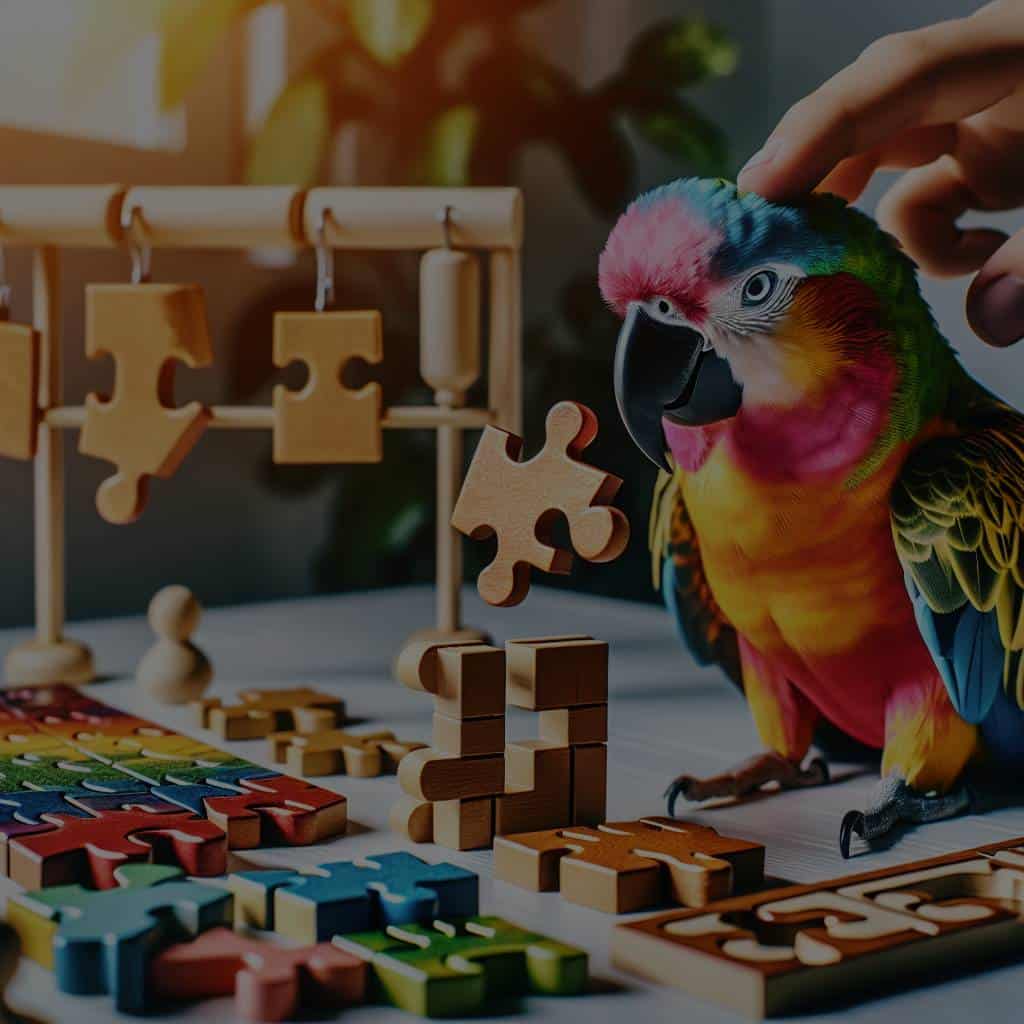Playing with toys is not only a way to keep your parrot busy. It’s also an important part of their mental and physical health. As pet owners, it’s your responsibility to provide appropriate toys and introduce them to the joy of play. Puzzle toys, specifically, are a fantastic way to keep your parrot engaged and mentally stimulated. But what’s the best way to introduce these toys to your feathered friend? How do you ensure that your parrot will not just interact with the puzzle toy but also learn how to solve it? Let’s explore this topic in-depth to help you become an expert in parrot playtime.
Understanding Your Parrot’s Play Preferences
Before you can introduce puzzle toys to your parrot, it’s important to understand their play preferences. Parrots, like people, have unique personalities and individual likes and dislikes. Some parrots might prefer large, colorful toys, while others might be more interested in toys that make noise or have interesting textures.
This might interest you : What Are the Optimal Tank Conditions for Breeding Neon Tetras?
Pay attention to the types of toys your parrot naturally gravitates towards. This will give you a good idea about their play preferences. From there, you can start introducing puzzle toys that align with these preferences. For example, if your parrot enjoys toys with bells or other noise-making elements, try introducing a puzzle toy that makes a sound when solved.
Remember, it’s important to introduce new toys gradually. Too much change at once can be overwhelming for your parrot. Start by introducing one new puzzle toy at a time and see how your parrot responds.
Also to read : How Can You Create an Enriched Environment for an Arthritic Senior Rabbit?
Making Puzzle Toys Safe and Attractive for Your Parrot
Safety should always be a priority when choosing toys for your parrot. Make sure any puzzle toys you introduce are made from safe, non-toxic materials. Avoid toys with small parts that could be easily swallowed or cause choking.
Size is another important factor to consider. Ensure the toy is appropriate for the size of your parrot. Small toys could pose a choking risk, while large toys could be intimidating or difficult for your parrot to interact with.
To make the puzzle toy more attractive to your parrot, consider incorporating food or treats into the toy. Foraging for food is a natural behavior for parrots, and a puzzle toy that dispenses treats when solved can be a huge hit.
Using Positive Reinforcement to Encourage Interaction
Positive reinforcement is a powerful training tool when teaching your parrot to use puzzle toys. This involves rewarding your parrot for interacting with the toy in the desired way.
You can use treats as a form of positive reinforcement. When your parrot interacts with the puzzle toy, immediately reward them with a small treat. Over time, your parrot will associate interacting with the toy with receiving a reward, encouraging them to continue interacting with the toy.
Remember, patience is key. Your parrot may not solve the puzzle toy right away, but any interaction should be rewarded to encourage continued play.
Gradually Increasing the Difficulty Level
As your parrot becomes more comfortable with puzzle toys, it’s important to gradually increase the difficulty level. This will keep your parrot engaged and continue to provide mental stimulation.
Start with simple puzzle toys that can be solved easily. As your parrot learns to solve these puzzles, introduce more complex toys. This gradual increase in difficulty will keep your parrot challenged and help to prevent boredom.
Remember to always watch your parrot’s behavior when introducing new toys. If a toy is too difficult, your parrot may become frustrated and lose interest in playing. It’s important to find a balance between challenging your parrot and maintaining their interest in play.
Incorporating Puzzle Toys into Your Parrot’s Regular Routine
To ensure your parrot continues to engage with puzzle toys, it’s important to incorporate these toys into their regular routine. This can include playtime outside of the cage, supervised play sessions with you, or even leaving the puzzle toy in their cage while you’re away.
Rotate different puzzle toys to keep things fresh and exciting for your parrot. This will prevent them from getting bored with a single toy and encourage them to explore different types of puzzles.
Remember, play is an important part of your parrot’s mental and physical health. By introducing puzzle toys and using these strategies, you can provide enrichment for your parrot and help them lead a happy, healthy life.
The Role of Foraging Toys in Parrot Playtime
Foraging toys are a form of puzzle toys that can be instrumental in keeping your parrot both mentally and physically active. As the name suggests, these toys are designed to mimic the bird’s natural foraging behavior, providing both a challenge and a reward.
Think of these toys as an interactive pet store for your bird. They usually involve hiding food or treats within the toy and require the bird to work out how to reach the reward. This not only provides your parrot with much-needed mental stimulation but also keeps them physically active as they navigate their way through the toy.
To introduce foraging toys to your parrot, begin with simple designs that your pet bird can easily navigate. For instance, you can start with foot toys, which are small enough to be manipulated by your parrot’s foot or beak. As your bird gets more accustomed to the toy, you can gradually introduce more complex foraging toys.
When using foraging toys, remember to keep the treats healthy and varied. Just like us humans, parrots appreciate variety in their diet. Rotate different types of food and treats to keep your parrot’s interest piqued.
While introducing foraging toys, also consider employing clicker training. This involves using a small device that makes a unique sound. When your parrot successfully navigates the foraging toy, you can make the sound and then offer a reward. Over time, your parrot will associate this sound with success, making the learning process faster and more enjoyable.
Creating a Stimulating Parrot Playbook: Overview and Conclusions
To recap, introducing puzzle toys, and particularly foraging toys, to your parrot playtime can have a significant impact on your pet bird’s mental and physical health. However, it’s essential to take your parrot’s unique personality and preferences into account. Every bird is different, and what works for one won’t necessarily work for all.
Ensure the toys you introduce are safe and appropriate for your parrot’s size. Incorporate food or treats into the toys to increase their appeal and use positive reinforcement to encourage interaction. As your parrot becomes more comfortable with the toys, gradually increase their complexity to keep your bird challenged and engaged.
In addition, remember it’s vital to incorporate these toys into your parrot’s regular routine and keep rotating different puzzle toys to avoid boredom.
Keeping your parrot mentally stimulated doesn’t have to be a complicated process. With the right toys, a bit of patience, and a lot of love, you can enrich your pet bird’s life significantly. After all, a happy, healthy parrot is the ultimate goal for all pet bird owners.
Now that you have your parrot playbook, it’s time to put these strategies into practice. Happy playing!






